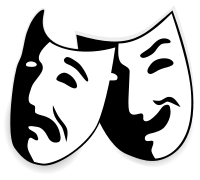Drama is one of the curricular areas in which many teachers fear teaching. They don’t want to take the risk that if they bring their class onto the school stage, chaos will erupt, and behavioural management becomes more difficult to implement than ever before. With these assumptions, I ask how are we to encourage children to take risks in their learning if we are not doing so ourselves? Dickenson and Neelands write about how it could convey the need for gender mixing and space and resource management.
This video provides a form of solution that teacher’s may exhibit when planning the drama lesson, and actually turn it round into one of the most exciting moments of the timetable.
The first step is establishing an agreement The Drama lesson should always begin with an agreement. This is a necessity, as no individual can be forced into participating. As such, a negotiation can be put in place to encourage joining in. For those pupils who might struggle to do so, using drama techniques in the classroom may be an introductory method to aid them e.g. hot seating. According to Dickenson and Neelands, there are no shortcuts to strategy management, and the issues that need solved are likely to be magnified within Drama.The lesson conveners in the video use the ‘Three C’s’. If a problem were to occur, it’s likely the child facing it is either not communicating effectively, co-operation fairly, or concentrating fully. As teachers, we must be mindful that everyone in the Drama lesson must follow the agreed contract, and that when said contract is broken, everyone should be responsible for deciding the consequence. Consistency is key. Otherwise, what is the point of the contract being in place? Warming up is obviously where the body is prepared for the forthcoming activity. What perhaps isn’t as glaring is that the mind is also being prepared, as the participants are beginning to differentiate from the Maths lesson they just had in the classroom 15 minutes ago. The video referenced above then conveys the importance of given the children a focus, to perpetuate further development. Photographs were used as a stimulus to establish a clear focus. As the children take grasp of this, an allowance for deeper thinking of initial ideas is provided. Visualisation is where the teacher tells a story as children close their eyes, translating the teacher’s words into an imaginative picture in their minds. The soundscape is where the pupils become engrossed into their environment and they can begin to share what they hear and where these noises are originating from. This can link to other areas of the curriculum e.g. geography: the different features found in various environments. The bodyscape then allows pupils to create their own structure, using nothing apart from their own and their peers bodies. No props – but still lots of room for improvisation. As the room/hall falls silent, a simple tap on the shoulder from the teacher allows the pupils to voice their feeling: what are they thinking? After a lesson of active learning (not that active has to be moving around!), it’s vital that there is time and effort made to provide an evaluation, as a calming from the physical activity. This segment may include, though not visible, a self realisation for the children. During Drama, all strengths of a given group must be used, and so children may begin to rethink their opinions on their peers.

References – all accessed 03/02/18
Text Content:
Dickenson, R & Neelands, J. (2006) Improve Your Primary School Through Drama. Oxon: David Fulton Publishers. – Chp.3: Getting Ready for Drama.
http://archive.teachfind.com/ttv/www.teachers.tv/videos/ks1-ks2-drama-teaching-drama-a-structured-approach.html
Images:
https://commons.wikimedia.org/wiki/File:No_drama.svg
https://commons.wikimedia.org/wiki/File:Comedy_and_tragedy_masks_without_background.svg
